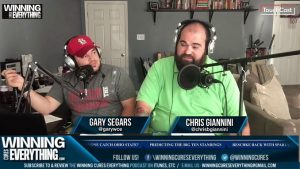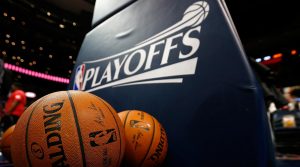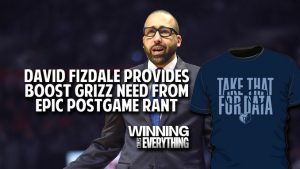On November 13, 2017, Mike Conley went 2 of 12 from the field in 33+ minutes of actions for the Memphis Grizzlies in a 7 point loss to the Milwaukee Bucks.
After that loss, the Grizzlies were 7-6, after starting the season 5-1. Conley has not played since.
From the time that Conley has been sidelined, the Grizzlies have gone 10-23. They are currently 17-29, and are sitting at 12th place (out of 15) in the Western Conference, and, if the season were to end today, they would have the 6th pick in the NBA draft (before the lottery process).
FiveThirtyEight.com has the Grizzlies projected to finish 32-50, which would be a 15-21 end to the season, and would have the Grizzlies picking 7th in the NBA Draft. They have a 2% chance to make the NBA Playoffs this year, which would be the 8th straight season.
Is “tanking” the best plan for this season?
At what point does “tanking” become the best course of action for the long-term future of this team?
For those of you that don’t know what I’m talking about, tanking is given a great definition by Urban Dictionary:
Tanking is the act of giving up a match or “throwing it away”, losing intentionally or not competing
The Grizzlies have made the playoffs for 7 straight seasons.
Even with “tanking” there’s no guarantee that you’ll end up with a great draft pick, because there are misses every single year, and the Grizzlies have not exactly had a good track record with draft picks.
That does not mean that it’s not better to have higher draft picks.
Can’t you get good players anywhere in the top 10 in the draft?
Let’s try and dig through some of these numbers.
The best summary of first round draft picks in the NBA was put together in this article at 82games.
This is their explanation of the ranking:
Since B-R provides career games, and then per game points, rebounds, assists and minutes, I have gone with an admittedly highly simplistic look on things by just going with:
Rating = points/game + rebounds/game + assists/game
Why use this definition? It’s the data I have easily on hand, which while not a good player rating system is a decent wag for these purposes. Then I group players as follows:
• Star — 20+ rating
• Solid — 15 to 19.9
• Role Player — 10 to14.9
• Deep Bench — 5 to 9.9
• Complete Bust — less than 5
• DNP — (never played in the NBA)
Here are the historical numbers behind the first 3 picks of the NBA draft:
These numbers show that, in the first 3 picks of the draft, you’re guaranteed to have a star player 71.7% of the time. That’s better than 7 out of 10 draft picks. Not too shabby. Now, let’s take a look at picks 4-5.
Not too shabby here either. These 2 picks have a hit rate of 60%. That’s not close to the 71+% hit rate for star power that the top 3 picks give you, but 6 out of 10 is still a great number.
Here is where things get a little crazy. As of today, FiveThirtyEight.com has the Grizzlies predicted to finish 6th from last in the NBA, which means they would have the 6th best chance at the #1 pick… and if they did not get a top 3 pick, then they would be picking 6th.
Here are the projections:
So if they end up with the 6th-10th pick, this is what the odds look like for getting a star, or even a solid role player.
That’s where the numbers start to sag a bit.
- 31% odds of getting a star player
- 24% odds of getting a solid starter
- 26% odds of getting a role player
While these odds are definitely better than selecting later than the 10th pick (in fact, the only pick with higher odds of getting a star player than 20% is pick 14 at 25%), you still see how drastically the odds fall from 4-5 to 6-10.
If you have a top 5 pick, this is what your odds look like:
- 67% odds of getting a star player
- 21% odds of getting a solid starter
- 9% odds of getting a role player
Obviously, because the star player odds are so high here, you don’t get great odds for a “solid” or “role” player. But that doesn’t matter, because in the top 5, nearly 70% of the picks end up being “stars.”
That’s incredible.
Obviously, you can end up with all-stars just about anywhere else in the draft… but the odds are so low that it would make sense to want to draft in the Top 5. Obviously, there’s still a 3% chance you could end up with a complete bust in the top 5, but the odds are not great, even though Grizzlies fans have seen it up close with #2 pick Hasheem Thabeet.
So for a team like the Memphis Grizzlies, why wouldn’t “tanking” be the best course of action?
Winning has to matter… to the players
The Memphis Grizzlies have developed a winning culture in the last 8 years in this city.
The coaches can change (from Lionel Hollins to Dave Joerger, to David Fizdale, to current interim JB Bickerstaff), players can come and go (as they have over the years), but the one thing that has remained the same is the winning culture.
Players that play for losing organizations, for coaches and front offices that don’t care about winning, get a bug in them that it’s ok to lose.
The Grizzlies have 11 players that have 4 years or less experience, 10 that have 3 years or less, and 7 players that are either rookies or are in their 2nd year in the league.
These players have to learn how to win, because losing is a habit that can be broken.
In my opinion, rather than trying to lose, and letting it be known that the franchise wants to lose, the coaches and the organization have to try and teach these kids winning basketball.
Cheer for them to win. If they lose, then ok, but that doesn’t mean the organization should stop trying, just to attempt to get a better draft pick.
Winning manifests winning.
If you want a successful franchise that maintains a winning culture, you cannot accept losing.







